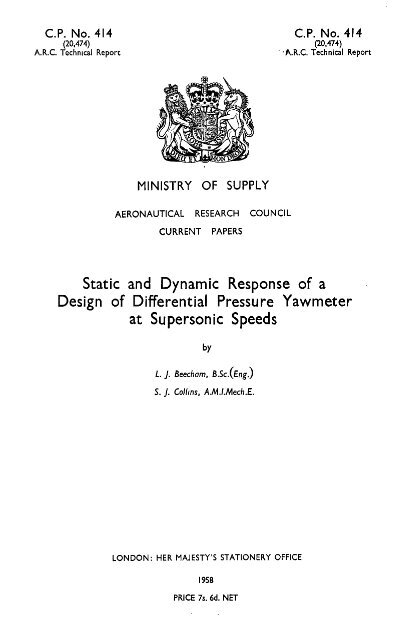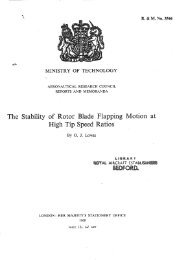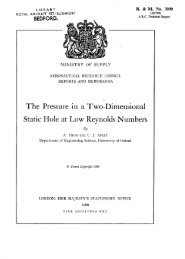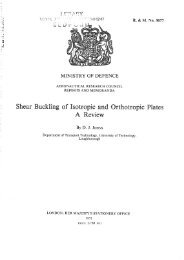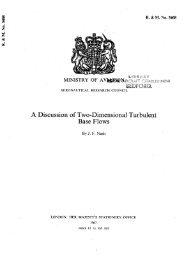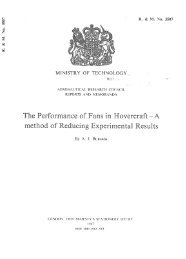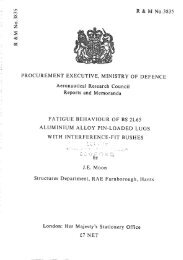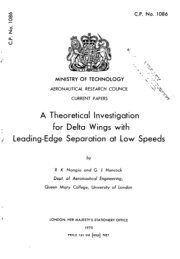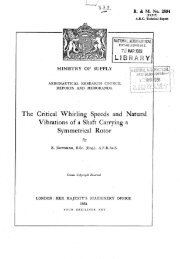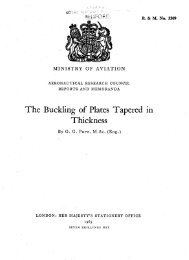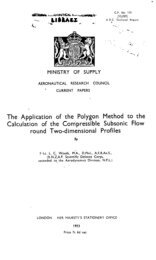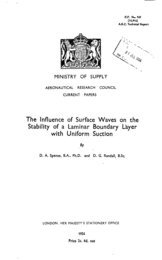Static and Dynamic Response of a Design of Differential ... - aerade
Static and Dynamic Response of a Design of Differential ... - aerade
Static and Dynamic Response of a Design of Differential ... - aerade
Create successful ePaper yourself
Turn your PDF publications into a flip-book with our unique Google optimized e-Paper software.
c. Pi.$-lj 4 I4<br />
A.R.C. TechnIcal Report<br />
MINISTRY OF SUPPLY<br />
AERONAUTICAL RESEARCH COUNCIL<br />
CURRENT PAPERS<br />
c.P.l+l~i~ 4 I4<br />
‘P.R.C. Technical Report<br />
<strong>Static</strong> <strong>and</strong> <strong>Dynamic</strong> <strong>Response</strong> <strong>of</strong> a<br />
<strong>Design</strong> <strong>of</strong> <strong>Differential</strong> Pressure Yawmeter<br />
at Supersonic Speeds<br />
L. J. Beecham, B.Sc.(Eng.)<br />
S. J. Co//m, A.M.1.Mech.E.<br />
LONDON: HER MAJESTY’S STATIONERY OFFICE<br />
1958<br />
PRICE 7s. 6d. NET
U.D.C. iio. 533.6.~54:533.6.~83.?:533.6.Gl3.1~4:533.6~~.01~.5<br />
static ma lDymmic Jicspoose <strong>of</strong> a Cesi!g <strong>of</strong><br />
Dif?er~ntiel. Fressicre Yawmeter at Supersonic Speeds<br />
L. J, Eeechem, 3.Sc.(Eng.)<br />
<strong>and</strong><br />
S. J. Collins, A.!i.f.&ch.E.<br />
C.P. No.414<br />
<strong>Static</strong> c,alibration our~es
List <strong>of</strong> Syrdmls<br />
1 Introduction<br />
2 Test ecpipent<br />
3 <strong>Static</strong> response<br />
LIST OF CONTZXTS<br />
3.1 CaMration <strong>of</strong> pressure difference variation with<br />
incidence<br />
3.2 Discrepancy between present results ana those <strong>of</strong> ref.3<br />
3.3 Resolution dth roll angle<br />
3.4 Pitot <strong>and</strong> static pressure measurements<br />
3.5 Determination <strong>of</strong> incidence, roll an&e <strong>and</strong> Mach i'ro.<br />
from flight records<br />
4 <strong>Dynamic</strong> tests<br />
5<br />
References<br />
4.r <strong>Response</strong> equation<br />
it.2 Theoretical acoustic characteristics at supersonic<br />
speeds<br />
4.3 Measurement technique<br />
4.4 Tests <strong>and</strong> resulks<br />
4.5 Ihcrepancy between the response in still <strong>and</strong><br />
sqcrsonic air<br />
4.6 Further dwelopment<br />
Conclusiolls<br />
LIST OF APEWDICES<br />
Effect <strong>of</strong> inaccurate pressure hole location<br />
Condition that 25, t3
Details <strong>of</strong> yssvmeter head<br />
LIST OF ILLWl'RA?IONS<br />
CaXbration curves <strong>of</strong> differential Fessure versus incidence<br />
Variation <strong>of</strong> sensitivity with Mach Fo.<br />
Variation <strong>of</strong> difPerentia1 pressure with roll angle<br />
Resolution in pitch snd yaw<br />
Variation <strong>of</strong> pitot pressure with incidence<br />
Recorded static pressure variation with incidence (Id = 1.4)<br />
Relation betieen Mxh No. <strong>and</strong> 'o/p<br />
Charts for the determination <strong>of</strong> 13 <strong>and</strong> M in terms <strong>of</strong> the pitot<br />
pressure end the differential pressure in the combined plane<br />
Electrical analogue <strong>of</strong> yawmeter <strong>and</strong> pick-up system<br />
Relations betvreen acoustic damping <strong>and</strong> u.n.f. in flight <strong>and</strong><br />
wind tunnel <strong>and</strong> that in still air<br />
Dynsmic test eouiJzment<br />
Pressure pick-ups<br />
Yawmeter with built-in capacity type pick-up<br />
Pressure response <strong>of</strong> yawmeter with bellovs pressure recorder<br />
Pressure response <strong>of</strong> yawmeter with built-in capacity pick-up<br />
to an impulse in still air<br />
<strong>Response</strong> <strong>of</strong> built-in version to mechanical vibration<br />
Time lag <strong>of</strong> interim (long tube) version progrsmmed + 15' at<br />
3 c.p.s. (M = 1.9)<br />
Steady state pressure response at fast progranwe speeds<br />
(capacity type pick-up)<br />
Fressure difference due to an irdependent (subsonic) cross<br />
flow velooity<br />
Geometric relations between indicated <strong>and</strong> true incidence end<br />
roll angle<br />
S<br />
-3-<br />
a<br />
I<br />
2<br />
3<br />
4<br />
5<br />
5<br />
7<br />
a<br />
9<br />
10<br />
II<br />
12<br />
13<br />
14<br />
15<br />
16<br />
17<br />
18<br />
19<br />
20<br />
21
3<br />
a<br />
*I<br />
*2<br />
c1<br />
c2<br />
a.n.r.<br />
g(s)<br />
G(S)<br />
i<br />
k<br />
K(M)<br />
e<br />
L1<br />
L2<br />
"I<br />
m2<br />
x<br />
"I<br />
n2<br />
P<br />
PO<br />
*pit<br />
*ii<br />
*PI<br />
**2<br />
AP<br />
speed <strong>of</strong> sound<br />
tube cross-sectional area<br />
LIST OF SYMEOLS<br />
--<br />
chamber cross-sectional area<br />
acoustic capacitance <strong>of</strong> the pick-up chamber<br />
acoustic eauivalent <strong>of</strong> the diaphragm compliance<br />
dmped natural frequency<br />
initial condition functions<br />
acoustic equivalent <strong>of</strong> electrlcal current<br />
length <strong>of</strong> connecting tube betveen pressure holes <strong>and</strong> pick-up<br />
acoustic uxl~ctance <strong>of</strong> the air in the pressure tubes<br />
acoustic equivalent <strong>of</strong> the diaPhragm mass<br />
air mass in each pressure tube<br />
mass <strong>of</strong> pick-up diaphragm <strong>and</strong> moving parts<br />
free stream Mach No.<br />
2x x acoustic d.n.f. = q - z,+<br />
27: x mechanical d.n.f. = (c$ - 2)"<br />
pressure cn hemisphere surface<br />
stagnation Pressure (behind norrral shock at supersonic speeds)<br />
pressure registered at axial pitot hole<br />
free stream static pressure<br />
differential pressure between holes forming roll datum<br />
differential pressure betc7een holes nr=J to roll datum<br />
differential Pressure in the combined (0) plane<br />
-4-
9<br />
Q<br />
r<br />
rl<br />
'2<br />
pick-up chamber volume<br />
LIST OF SD53OLS (COXTD)<br />
radius <strong>of</strong> connecting pressure tubes<br />
T<br />
w<br />
w<br />
w<br />
2<br />
a distance from inlet holes to the instantaneous centre <strong>of</strong><br />
rotation<br />
Rs<br />
R1<br />
R2<br />
radius <strong>of</strong> hemispherical head<br />
acoustic resistzmce <strong>of</strong> pressure lines<br />
acoustic equivalent <strong>of</strong> the tiphmgm mechanical resistance<br />
S Laplace transfom parameter<br />
t time variable<br />
u.n.f. undamped naturzl frequency<br />
U free stream velocity<br />
v pressure registered by pick-up<br />
v pressure at yawmeter inlet holes<br />
vO<br />
Input pressure amplitilrle<br />
zq ,Z& equivalent acoustic impedances<br />
z, LS+X<br />
1 1<br />
1<br />
L2s + n2 + p<br />
1<br />
qE<br />
incidence in plane <strong>of</strong> holes forming roll datum<br />
incidence normal to plane <strong>of</strong> holes forming roll datum<br />
phase angle<br />
acoustic damping factor = 5<br />
mechanical damping factor = -<br />
w2<br />
-5-<br />
wl
3<br />
Superscriots<br />
. L<br />
at<br />
Other suffices<br />
LIST OF smu (CONTD~<br />
dynamic viscosity <strong>of</strong> air in pressure lines<br />
incidence <strong>of</strong> yawmeter axis to the free stream<br />
nominal angular 3ocation <strong>of</strong> pressure holes relative to<br />
yaxmeter axis<br />
AC'CUCJ location <strong>of</strong> ir.Z.vidual holes<br />
air ?ensity in free strean<br />
air density in pressure line<br />
t3.m lag<br />
roll angle<br />
9 + er2<br />
ZJ~ x forc&rg frequency<br />
2% x acoustic u.n.f.<br />
2X x mec~ical u.n.f.<br />
Laplace operator form<br />
E manufacturing error<br />
F in flight conditions<br />
I indicate cl<br />
T in xind tunnel conditions<br />
-6-<br />
00<br />
( i.e. 7 = s ve-st at ><br />
0
1 Introduction<br />
Until. fairly recently no direct measurement <strong>of</strong> the incidence <strong>of</strong> a<br />
body or surface to the free stream direction had been made in the course<br />
<strong>of</strong> supersonic missile flight trials carried cut in this country. In the<br />
R.A.E./G.3. Dept. tests the steady state (trim) incidence has in the past<br />
been obtained in a roundabout way during the determination <strong>of</strong> the aero-<br />
dynamic pitch derivatives from the normal acceleration, response frequency<br />
<strong>and</strong> ckrping <strong>of</strong> a progranrmed test vehicle. The derivatives so obtained<br />
refer to small perturbations about the steady state conditions, <strong>and</strong><br />
generally one round. has provided information at one incidence only. ai'ith<br />
linear aerodynamics two rounds are required to furnish all the required<br />
data at one incidence; in pra&iCe the derivatives are <strong>of</strong>ten non-linear<br />
with incidence <strong>and</strong> several more rounds are necessary to provide a coqlete<br />
picture.<br />
Thhjs method is costly in rounds as well as being sensitive to round-<br />
to-round asynrmetries, <strong>and</strong> some direct means <strong>of</strong> determining the attitude <strong>of</strong><br />
the missile or its surfaces to the free stream direction is obviously<br />
desirable. An incidence measuring instrument <strong>of</strong> even a slow resrJonse would<br />
be sufficient to measure the trim angle. an instrument with a response<br />
frequency high enough to record the instantaneous incidence during a<br />
transient motion would decrease very considerably the firings needed to<br />
produce the same data as in the past.<br />
The types <strong>of</strong> instrument suitable for this purpose fall into two<br />
principal classes, viz.<br />
(i) those in which the incidence is registered directly a9 the<br />
angle turned through by a surface in aligning itself along<br />
the local stream direction (the surface may have one or more<br />
degrees <strong>of</strong> freedom), <strong>and</strong><br />
(ii) those which remain fixed in missile axes, snd whose function<br />
depends upon the extent <strong>of</strong> the f?orr changes induced by<br />
incidence.<br />
An example <strong>of</strong> the former is the low aspect ratio delta wing vane <strong>of</strong><br />
which several designs with freedom in one, <strong>and</strong> letterly two,planes are<br />
nom available. These have the merit <strong>of</strong>' recording the flow inclination,<br />
which, providing interference from the missile is avoided, gives the<br />
incidence directly. However they have at present a limited range <strong>of</strong> angle,<br />
<strong>and</strong> it has not yet been established that with one degree <strong>of</strong> freedom they<br />
will resolve correctly when the motion <strong>of</strong> the vane relative to the missile<br />
is not in the pitch plane.<br />
The principal example <strong>of</strong> the other class is the differential pressure<br />
yammeter*, <strong>and</strong> it is with this type that this report is concerned. A<br />
number <strong>of</strong> designs sre available utilising the pressure differences set up<br />
between pairs <strong>of</strong> holes in the instrument when at incidence. In this way<br />
the pressure difference msy be registered in any plane by appropriately<br />
positioning the holes; in general for a cruciform missile two pairs only,<br />
with their joins perpendicular, are required <strong>and</strong> it is probable that these<br />
woul?~ be aligned so as to record normaJ.ly to the kng planes.<br />
*The term "yawmeter" is used throughout to describe an instrument<br />
measuring incidence in any plane.<br />
-7-
This type <strong>of</strong> instrument has the disadvantage that the sensitivity,<br />
i.e. the pressure difference per degree <strong>of</strong> incidence, is dependent on<br />
both Mach No. <strong>and</strong> the ambient atmospheric pressure in flight. This may<br />
require a pressure pick-up sensitive over a wide range when the missile<br />
is to be flown in widely varying speed <strong>and</strong> altitude oonditions. As far<br />
as the reduction <strong>of</strong> the data is concerned the dependence on ambient<br />
pressure need present little difficulty. Under flight trial conditions<br />
the ambient air pressure is air-rcys deducible from trajectory <strong>and</strong> meteoro-<br />
logical information, <strong>and</strong> it is not unlikely that methods can be developed<br />
to measure it by pick-ups in the missile itself. The Mach Ho. can con-<br />
veniently be determined by measurement <strong>of</strong> the supersonic pitot pressure .<br />
in conjunctionwath the statac (ambient) air pressure, <strong>and</strong> this can be<br />
obtained either from a separate instrument, or, as ~111 be shop, by a<br />
suitable pressure hole in the yawmeter head. Athough less direct in<br />
operation this instruwnt has some advantages over the vane type. It<br />
has, for instanoe, a much larger potential incidence range SUXF: there-are<br />
no maohanioai llmatatiors, <strong>and</strong> it has already been shown to resolve the com-<br />
ponert angles satisfactorily at iroidenoes up to-loo, It has a further<br />
advantage that the pick-ups are interchangeable, <strong>and</strong> thus the<br />
sensltlvity can be designed to give f;he largest signal appropriate to<br />
the operatjng conditions.<br />
The yawmeter exsmined in the present tests is a design on which a<br />
certain amount <strong>of</strong> static testing has already been done in 19" x 272 0.A.L.<br />
tunnel at Eaingerfield, Texas. The present tests examine in more detail<br />
the variation <strong>of</strong> static sensitivity with Mach No. <strong>and</strong> extend the incidence<br />
renge up to 30': roll resolution up to J5°incidence is investigated at 1<br />
one Mach Xo. In addition to the tests on the basic instrument, for which<br />
the angular location, eo, <strong>of</strong> the differential pressure holes relative to<br />
the axis is 45', calibrations are also given for 8, ; 4Y" <strong>and</strong> for so * 53. c<br />
As will be shomn the empirical &avfs derived suggest that the maximum<br />
sensitivity occurs with 0, + 54 .<br />
In addition an attempt IS made to measure the dynsmic response <strong>of</strong> the<br />
instrument anl associated recording equilmnent under still air <strong>and</strong> superecnic<br />
conditions, <strong>and</strong> to increase the response frequency as far as possible in<br />
order to render the instrument capable <strong>of</strong> registering missile incidence<br />
during transient motion.<br />
2 Test equipment<br />
All wind tunnel tests vere<br />
supersonic tunnel at atmospheric<br />
csrried out in the R.A.E. No.18 (9' x 9')<br />
stagnation pressure. For the static<br />
tests pressures were measured on an orthodox mercury manometer. l?cr the<br />
dynamic tests pressures were recorded initially on a bellows type pick-up<br />
using stylus-on-celluloid recordin 7 Jfig.l3a). Subsequently a capacity<br />
type differential pick-up (fig.13b rvas used in conjunction with frequency<br />
modulated capacity measuring equipment enabling the signal from the pressure<br />
iok-ulz to be displayed as a D.C. voltage on a cathode ray oscillosccpe<br />
P fig.12). The signal was recorded photographically by means <strong>of</strong> a Type 1428<br />
Cossor Camera, a suitable time base being injected. by a signal generator.<br />
1<br />
Details <strong>of</strong> the basic (00 = 45O) yawmeter head are given in fig.?.<br />
Several instruments were constructed in the course <strong>of</strong> develomentalmork,<br />
<strong>and</strong> details are given below:-<br />
-8-
Ref. p,To.<br />
1<br />
2<br />
3<br />
4<br />
5<br />
6<br />
3 <strong>Static</strong> response<br />
Details<br />
"One-<strong>of</strong>f static version" - also used for<br />
first dynamic tests with belloivs type pick-up<br />
"One-<strong>of</strong>f dynamic version" - used for inter-<br />
mediate dynamic tests with the capacity<br />
pick-up mounted outside the tunnel. Also<br />
used for roll resolution tests<br />
R.&E. production version - static tests at<br />
supersonic speeds<br />
De Havill<strong>and</strong> production version I - statio<br />
tests at supersonic speeds<br />
De Havill<strong>and</strong> production version 2 - static<br />
tests at transomc speeds<br />
R.A.E. version with built-in capacity<br />
pick-up - dynamic tests only.<br />
e<br />
0<br />
4a052f + 28'<br />
45O301 + 20'<br />
44O42' + 241<br />
52'48' + 30'<br />
52'20' + 10'<br />
Before the instrument could be used for precise flight test work it<br />
was felt that an elaboration <strong>of</strong> the previous wlibrations was desirable.<br />
In particular an extension <strong>of</strong> the calibration incidence range <strong>and</strong> the<br />
production <strong>of</strong> pressure difference versus incidence curves at smaller Mach<br />
No. increments were required, <strong>and</strong> also it was thought necessary to examine<br />
the resolution characteristacs <strong>of</strong> the instrument when the missile incidence<br />
plane was not in the plane <strong>of</strong> one or other pairs <strong>of</strong> holeg. It had previously<br />
been verified that up to angles <strong>of</strong> attack <strong>of</strong> 10 the instrument<br />
resolved correctly <strong>and</strong> it ma s necessary to extend the measurement <strong>of</strong> the<br />
deviation (i.e. indicated - actual incidence) up to 30 or more.<br />
3.1 Calibration <strong>of</strong> pressure difference variation with incidence<br />
-<br />
?or the calibration against angle <strong>of</strong> incidence the instrument was<br />
orientated so as to have nominally zero roll angle, i.e. the plane contain-<br />
ing the yawmeter axis <strong>and</strong> one pair <strong>of</strong> holes was arranged to coincide as<br />
nearly as possible with that in rrhich the instrument was pitched. The<br />
incidence datum was taken as that position in -which there was no pressure<br />
difference between these holes. The effects <strong>of</strong> small misalignment errors<br />
are examined in detail in Appendix I.<br />
At M = 1.3 the incidence obtainable was limited to '25' by tunnel<br />
blockage; at all the $igher speeds the pressures were measured over an<br />
incidence range <strong>of</strong> 30 .<br />
The yawmeter calibration curves, obtained by differencing the pressures<br />
at each incidence, are given in figs.2. The pressures have been non-<br />
dimensionslised with reference to the static pressure 0% the undisturbed<br />
stream. These curves show that for incidences up to 10 the yawneter<br />
behaves almost linearly, but at higher angles there is
P = Pa-c y (Po - ps) sin*$<br />
where ps <strong>and</strong> po are respectively the free stream static <strong>and</strong> stagnation<br />
preSSU?XS. If $ is regarded as consisting <strong>of</strong> an angle 6 relative to<br />
0<br />
an axis fixed in the sphere, <strong>and</strong> an angle 8 between this axis <strong>and</strong> the<br />
free stream direction it is readily shown that the pressure difference<br />
between Oiyo synrmetrically disposed holes is<br />
AP = 2 5 - 1 sin 28 sin 28<br />
T 0<br />
4 ( ps ><br />
($ma = z(? - 1) sin 20 for 8, = 45'<br />
Comparison <strong>of</strong> equation 3 with the experimental curves shows that the<br />
non-linearity with 0 is prescribed veryweli by sin 28 (fig.2), but that<br />
the slope,<br />
a!!2<br />
0 ps<br />
a(h ae) 9 differs considerably from -$$ - 1) at supersonic<br />
s<br />
speeds (fig.3). It is found, however, (see para.3.5) that the sensitivity<br />
is given very closely by rl f,actor <strong>of</strong> roughly similar form, viz.<br />
, where, at supersonic speeds, o<br />
-o is the stagnation pressure<br />
behind a normal. shock at the relevant Msch No. <strong>and</strong> K, = 0.925 <strong>and</strong> 0.954<br />
for e<br />
0<br />
= 4!?<strong>and</strong> 53' respectively, The empirical curves are plotted on<br />
fig.3 together tith experimental results obtained from the one-<strong>of</strong>f static<br />
(No.1) <strong>and</strong> dynamic test (NO.*) instruments, <strong>and</strong> also for the production<br />
versions (Nos.3, 4) made by R.A.E. <strong>and</strong> De Havill<strong>and</strong> propellers Ltd. The<br />
effect <strong>of</strong> differences in angular location <strong>of</strong> the holes on the hemisphere<br />
appears to be small but nevertheless the maximum sensitivity ia obtained<br />
for a value <strong>of</strong> e, somewhat greater than 45'.<br />
Also included on this figure ere preliminary values obtained with<br />
No.5,at trensonic <strong>and</strong> high subsonic speeds over a small incidence range<br />
(2 4 ) in the N.A.E. 3 ft x 3 ft wind tunnel, Ihis nork carried out by<br />
N.A.E. Staff, has been reported in detail in refer-en-e 2.<br />
3.2 Discrepancy between the present results <strong>and</strong> those <strong>of</strong> reference 3<br />
It is apparent from fig.3 that there is a considerable discrepancy<br />
between the results <strong>of</strong> the present calibration end that carried out at<br />
Daingerfield with virtually the ssme instrument as No.3.<br />
- 10 -<br />
(2)<br />
(3)<br />
'<br />
.
The source <strong>of</strong> this discrepancy is not known. It has been demonstrated<br />
that considerable latitude can be given to the location <strong>of</strong> the holes without<br />
much change <strong>of</strong> sensitivity, so that, on the assumption that the pressure<br />
measuring equipment is above suspicion the indication is that the cause<br />
lies in pr<strong>of</strong>ile differences. It points the need for precision msnufsoture<br />
<strong>of</strong> these instruments if they are to be widely adopted as st<strong>and</strong>ard equipent.<br />
3.3 Resolution with roll angle<br />
Tests to examine the ability <strong>of</strong> the instrument to resolve correctly<br />
when the holes are asymmetrically<br />
were carried out at one Mach Xo.<br />
disposed<br />
(M = 1.4)<br />
with<br />
only,<br />
respect<br />
but it<br />
to the pitch<br />
is felt that<br />
plane<br />
the<br />
results can be applied qualitatively throughout to the gpeed range <strong>of</strong> tests<br />
in the previous section. Fr~ssures were measured at 15 increments in go11<br />
over the r-ange Oto YOt<strong>and</strong> 5 increments in incidence over a range + 35 .<br />
For design reasons it was not practicable to use the calibrated<br />
Nos.1, 3, 4 for these tests; instead they n&r& carried out with<br />
instruments<br />
the one-<strong>of</strong>f<br />
dynamic test version, Ko.2, used. for the dynamic response tests <strong>of</strong> section 4.<br />
The differential pressure is shown plotted in fig.4 against roll<br />
angle, 4 , <strong>and</strong> it is apparent from the curves that there nas a roll mis-<br />
alignm%nt error <strong>of</strong> -2 <strong>and</strong> a misalignment <strong>of</strong> the yawmeter <strong>and</strong> stream aXeS<br />
<strong>of</strong> 0.3 . These have been corrected for in fi .5 which shows the relation<br />
between the known stresmwise* incidence, u , 7 where sin a = sin 9 cos $ )<br />
in the plane <strong>of</strong> the holes <strong>and</strong> that indicated by the pressure difference<br />
between these holes as determined by the values at $ = 0. For correct<br />
resolution all the points should be on a single curve; instead they are<br />
seen to be on a series <strong>of</strong> narrow envelope curves, corresponding to constant<br />
values <strong>of</strong> 8 , the width <strong>of</strong> the envelope indicating the extent to which the<br />
pressure difference is depegdent upon roll angle. Over the range <strong>of</strong><br />
incidence, 8, from 0 to 35 the maximum deviation <strong>of</strong> the indicated from<br />
the actual incidence in tQe plane <strong>of</strong> the pressure holes occurred at roll<br />
angles b&keen 40 <strong>and</strong> 60 . The magnitude is given below:-<br />
3.4 Fitot <strong>and</strong> static pressure measurements<br />
Deviation as % <strong>of</strong><br />
actual incidence<br />
Although the present tests are princiIal.ly concerned with the<br />
behaviour <strong>of</strong> the instrument as a flop angle measuring deviue it is<br />
evident from the foregoing sections that, since the sensitavity is a<br />
function <strong>of</strong> both static pressure <strong>and</strong> Mach No., additional information is<br />
required before the incidence can be deduced from a differential pr&ss~P~<br />
measured during flight. To this end pitot ,en.d static holes were provided<br />
in the instrument, the for?ner axially disposed on the hemisphere so as to<br />
register stagnation pressure at sero incidence, <strong>and</strong> the latter positioned<br />
*As distinct from the so-called "chordwise ' definition, tan a = tan 8 co9 4.<br />
- 11 -
3-$ calibres behind the nose in accordance nith the recommendations or<br />
reference 3, <strong>and</strong> arranged as a circumferential ring <strong>of</strong> 12 equally spaced<br />
holes. Tests were carried out to see to what extent the pressures recorded<br />
at incidence differed from the lrnown stagnation <strong>and</strong> static pressures.<br />
The variation <strong>of</strong> pitot pressure with incidence is shown in fig.6,<br />
non-dimensionalised in terms <strong>of</strong> ps. It was found by plotting<br />
Ppit<br />
Ps<br />
i.e.<br />
PO<br />
p against<br />
for constant incidence, 8 , that o - 6 is proportional to<br />
cp PS ><br />
the constant <strong>of</strong> proportionality being given closely by set<br />
This variation is also shown in fig.6. It is <strong>of</strong> interest that<br />
equation 4 is found to predict very closely indeed the pressure distribution<br />
over the whole <strong>of</strong> the hemisphere, <strong>and</strong> to collapse 2 great deal <strong>of</strong> existing<br />
pressure data obtained over a wide range <strong>of</strong> supersonic speeds.<br />
pe static pressers at M = 1.4 as recorded at the holes in the<br />
cylindrical body are shonn in fig.?, non-dimensionslised again with<br />
respect to the true free stream static pressure. 'Thesg pressures are .<br />
noticeably dependent on the incidence, the value at 17 being only 72$ <strong>of</strong><br />
that at zero angle. Certain modifications to the size, shape snd number<br />
<strong>of</strong> holes were tried, but they effected no significant improvement. It is<br />
thought unlikely that an accurate measurement <strong>of</strong> static pressure will be<br />
obtained with this type <strong>of</strong> instrument where the pressure holes are subject<br />
to the influence <strong>of</strong> the vortices shed from the body <strong>of</strong> the instrument at<br />
incidence.<br />
3.5 Determination <strong>of</strong> incidence, roll angle <strong>and</strong> D&zch No. from flight<br />
records<br />
In the application <strong>of</strong> this instrument to flight test work the<br />
requirement will in general be to derive the angles e <strong>and</strong> $5 inpolar<br />
axes, or a <strong>and</strong> P in Cartesian axes, together with Mach No., from a<br />
knowledge <strong>of</strong> three pressure ratios, viz.<br />
AP,<br />
p,'<br />
AP9<br />
;<br />
Ps<br />
m& Ppit<br />
ps<br />
the statio<br />
pressure, psy having been determined independently. This can be done by<br />
a tedious, purely iterative process from the curves given in figs.2 to 6,<br />
but the labour can be reduced, or eliminated depending upon the accuraay<br />
required, by several methods.<br />
Firstly, if the incidence range is small, say less than IO’, then<br />
the non-linesrities may be disregarded <strong>and</strong> the parsmeters evaluated as<br />
follows:-<br />
- 12 -<br />
S
P<br />
0 TPpit<br />
Pi3 ps<br />
<strong>and</strong> hence Mach No. from fig.8<br />
Ike, as elsewhere ir. this paper, then the reference wings are in-line<br />
with the holes forming the roll datum then af md a2 CCrESpOnd<br />
respeotively to the streaamise incidenoe <strong>and</strong> sideslip angles, a <strong>and</strong> fi.<br />
When the incidence is not smsll, incidence <strong>and</strong> Mach No. may be<br />
derived from the charts shown in fig.Y(a) <strong>and</strong> (b) which have been produced<br />
by interpolation, <strong>and</strong> at the lowest speed by extrapolation <strong>of</strong> the experimental<br />
&ta. If M is known from independent data then the pitot pressure<br />
readings are redundant, although they might possibly be used in conjunction<br />
with the 1Tach No. to provide ps- Ftwviding the errors in roll resolution<br />
are neglected (para.3.3) then the angles a4 <strong>and</strong> a2 may be extracted<br />
directly from figs.Y(s) to Y(b) by re ding o the incidences<br />
As, fiFP2<br />
the known i&h No., <strong>and</strong> the ratios - <strong>and</strong> - respectively.<br />
relevant to<br />
e <strong>and</strong> $<br />
may then be derived from the strearwvise incidence definition <strong>of</strong> pera.3.3,<br />
viz.<br />
giving<br />
p,<br />
sin a 1 = sin e cos jb<br />
sin a 2 = sin 8 sin $<br />
sin a2<br />
tanti = sin<br />
1<br />
ps<br />
sine = [sin*a, + Sh2a2]9<br />
If M is not known then the pressure difference in the combined<br />
plane IS required before the Mach No. can be determined. Since this<br />
pressure difference is non-linesr with incidence <strong>and</strong> the latter is not<br />
?amwn, an approximation is necessary. A convenient form is:-<br />
- 13 -<br />
7<br />
.._<br />
i<br />
i<br />
J<br />
(6)<br />
(5)
which zmounw ?;o assvr;lin~ thzt sin* 28 * sin220~ + sin22a2. 'The error<br />
introticed by this approximation, expressed as a fraction <strong>of</strong> the correct<br />
val~3 is:-<br />
1<br />
2rror = se0 e[1 - s3.n2e(cos4z$ + sin4p)]2 - 1 (8)<br />
<strong>and</strong> ?;he sign is such char; the ap?roximatlon overestwtes the pressure<br />
difference in zhe ccmbrned ;jane. The error 1s sex-c at 6 = 0 <strong>and</strong> YOO,<br />
ana a lil~imum <strong>of</strong> (I+$-tan%)~ - 1 at $ = 450; at 0 = 100, 2o" <strong>and</strong> 300<br />
this sinounts TO I, 3 <strong>and</strong>. C,J res,3ectively. Using &is value <strong>of</strong> h<br />
P<br />
9<br />
<strong>and</strong><br />
the meczzred value <strong>of</strong><br />
*<br />
<strong>and</strong> enterin: f'lg.9 at the appropriate pomp<br />
Ps '<br />
on the axes glvee first approxinztlons to Id <strong>and</strong> 0 .<br />
These values roll &ten be vri'chin the accuracy lirmts <strong>of</strong> the flight<br />
pressure dav., ITUT -d-~re jusr;if'icd, they may be refined further by at<br />
1~cst two methods. The first is to adopt -the above prooetirc for a knov3<br />
Kach PO., using: in this c?.sc the firsT npproxj;nazion to X, to derive a,<br />
<strong>and</strong> "2, 2nd hncc # rind O(equations 6 ) . The second is to evaluate<br />
f&e error given b;? eqw.ti.on 8 using 4 +<br />
from the first a.pproxi.mztion. This ,givcs 1 more accurate wlue <strong>of</strong> 5<br />
9<br />
is tke ocr~bincd ~lanc, __ -Gt this is t&n zscd in conjunction tith $@-<br />
9<br />
to cvo.luate 5 <strong>and</strong> M nfrcsh frcm fig.5. Par an exzmplc <strong>of</strong> these mctltis<br />
SC2 AppcnaJx III.<br />
Another method likely to be useful z.n simulator studies, o? elsewhere<br />
-here a func-iionai form is required, can be obtained from a consideration<br />
<strong>of</strong> fig.5, -the .?orm <strong>of</strong> kich leads to simple empu-ical expressions for p<br />
P<br />
end. 2. IT 1s noticeable that the 8-cons-canr; lines are strsight, <strong>and</strong><br />
pS<br />
These vhen p'oduoed cut The<br />
*<br />
axis at 0.5. I.~oreover zhe slope is<br />
PS<br />
v"r;r nearly proportional to 0 so that ve have the very convenient<br />
relatlonsbip,<br />
8 in degrees e<br />
tiere 112 = 30.1 for 6, f 53', <strong>and</strong><br />
= 31 for e. = 450.<br />
- 14-<br />
AP<br />
k2 g<br />
f- PS ><br />
(7)<br />
(9)
z&<br />
As before Ap + [(AP,)~ + (Ap,) ] ) ana 47.<br />
1 <strong>and</strong> a 2 maybe<br />
written for 6 , iirith Ap suitably subscribed. The importance <strong>of</strong> this<br />
result is that at the cost <strong>of</strong> an extra pressure measurement, Ppit<br />
ps<br />
, the<br />
evaluation <strong>of</strong> incidence can be achieved without a knowledge <strong>of</strong> the Mach No.<br />
Prom 9 we have<br />
( a F<br />
0 s<br />
atsin 28) I<br />
I e=o<br />
( ><br />
S<br />
PO<br />
= 0.954 p - 4 for e. = 53O, <strong>and</strong><br />
= 0.925 p-$<br />
PO<br />
fore<br />
0<br />
( ><br />
=45'<br />
9 i<br />
<strong>and</strong> these empirical functions for the sensitivity are shar;n on fig.3.<br />
They give remarkably good agreement with experiment even at transonic<br />
<strong>and</strong> hi& subsonic speeds.<br />
The sensitivity may also be derived directly from equation 4 by<br />
differencing <strong>and</strong> differentiating, with 0 = 2 8, vie.<br />
The factor given by equation 11 is within 3s <strong>of</strong> that <strong>of</strong> the<br />
appropriate term in equations IO.<br />
-j !<br />
f<br />
j (IO)<br />
It is readily shown f'rorz 11 that the sensitivity is a maximum when<br />
$ = cos<br />
-1 1<br />
J3 i.e. 54.7'.<br />
Derivation <strong>of</strong> the Mach So. requires the evaluation <strong>of</strong> 5<br />
PS<br />
I<br />
(II)<br />
, <strong>and</strong> this<br />
can be achieved by elimination <strong>of</strong> e between equations 4 <strong>and</strong> 9. However,<br />
since the fall <strong>of</strong>f in p with incidence is predounantly a square lam<br />
pit 17<br />
variation a good <strong>and</strong> convenient approximation to “0 is given by,<br />
ps<br />
(12)
where the factor 0.22, applicable to both e. = 45' <strong>and</strong> 53' within the<br />
order <strong>of</strong> approximation, has been obtained by fitting the experimental data.<br />
Roll sngle mav be determined approximately as tar<br />
-, Al'2<br />
-. Themaximum<br />
API<br />
error in this approximation, for which it is assumed that<br />
sm<br />
sin<br />
a2<br />
a C<br />
1<br />
is not more than 2' for an incidence <strong>of</strong> 30' in the combined plane,<br />
sin 2a2<br />
sm 2~7, ' c<br />
From any <strong>of</strong> these methods it is possible to derive close approximations .<br />
to mncidence, roll angle <strong>and</strong>, from 22<br />
PS<br />
, Kach No. (fig.8) directly from a<br />
meas.rement <strong>of</strong> three pressure ratios, viz. the ratios <strong>of</strong> the recorded pitot<br />
pressure <strong>and</strong> differential pressures across each pair <strong>of</strong> holes to the free<br />
stream static pressure (local smbient pressure in flight), These approximations<br />
can always be refined to any required degree by using them as a<br />
first stage in a successive approximation process.<br />
A typical worked example is given in Appendix III to demonstrate<br />
these various methods <strong>and</strong> to indicate the orders <strong>of</strong> the errors involved.<br />
4<br />
DJ?namic tests<br />
'I"ne tests under non-steady conditions were designed to measure the T<br />
response <strong>of</strong> the yawmeter <strong>and</strong> its auxiliary recording equipment, <strong>and</strong> to<br />
develop either or both as required to render the instrument suitable for<br />
flight test work. -<br />
The overall response is governed by both the mechanical <strong>and</strong> acoustic<br />
characteristics <strong>of</strong> the system, <strong>and</strong> for minimum phase lag betiveen actual<br />
<strong>and</strong> recorded incidence both the acoustic <strong>and</strong> mechanical u.n.f. (undamped<br />
natural frequency) should be as high as possible in conjunction with<br />
suitable damping. It has been pointed outelse>&re that the acoustic<br />
u.n.f. <strong>of</strong> pressure operated instruments incorporating considerable lengths<br />
<strong>of</strong> tubing can <strong>of</strong>ten be much lamer than the mechanical, <strong>and</strong> the emphasis<br />
therefore has been on obtaining an instrument for which the acoustic<br />
frequency is high compssed with the missile weather-cock frequency, for<br />
which 3 c.p.s. is taken here as typical.<br />
4.1 iiesponse equation<br />
The yawmeter <strong>and</strong> pick-up system is shoprn diagranraatically as an<br />
acoustic-mechanical combination in fig.lO(a). The difference in chamber<br />
pressures produces a deflection <strong>of</strong> a dia&rsgm,which constitutes the<br />
mechanical system. By the analogue method <strong>of</strong> reference 1, the system<br />
can be shown to be equivalent to the electrical circuit <strong>of</strong> fig.lO(b) in<br />
which<br />
R, is the acoustic resistance <strong>of</strong> the air in the pipes = -<br />
xrk<br />
& 4?<br />
IL,, IS the acoustic inductance <strong>of</strong> the air in the pipes = 3<br />
2<br />
C, is the acoustic capacitance <strong>of</strong> the chamber<br />
- 16 -<br />
8871<br />
i
R2 is the acoustic equivalefit <strong>of</strong> the diaphragmmechsnical resistance<br />
L2 is the acoustic equivalent <strong>of</strong> the diaphragm mass<br />
C2 in the acoustic equivalent <strong>of</strong> the diaphragm compliance<br />
V is the input voltage equivalent in Che aoou&ic system to the<br />
differential pressure.<br />
For convenience consider the generalised circuit <strong>of</strong> fig.lO(c) in<br />
which the impedeme in each branch oA * f'ig.lO(b) is denoted by Z tith an<br />
t<br />
approFiate subscript (Z is the operator R + L $ + h<br />
ZI=IutL~++ d1 ’<br />
+<br />
o “Idt\ ,.<br />
i<br />
The eouivalent impedance <strong>of</strong> the whole circuit, G, is<br />
ZE =<br />
(z, + z )(z*z, + z*z t 22,z )<br />
zqz2 + z2z3 c 2",Z3 t 2;<br />
The Input current, I, = dL <strong>and</strong> the current in Z2,<br />
%<br />
vz<br />
i = z,z2 t z2z3 t 22,z3<br />
i 0<br />
dt such that<br />
The pre-;sure registered by the pick-up is, by analogy, the voltage,<br />
v, across C2 in fig.lO(b), <strong>and</strong> this is given by<br />
v = 1<br />
c2 J<br />
ETm take the Laplace transforms <strong>of</strong> 14 <strong>and</strong> 15, <strong>and</strong> to avoid confusion with<br />
the symbol for pressure denote the Laplace trsnsfrm symbol by S instead<br />
<strong>of</strong> the more usual p, so that<br />
Then<br />
? =<br />
i<br />
0<br />
00<br />
i dt<br />
i emSt dt etc.<br />
VT3 + g(s)<br />
? = -- -- --<br />
z1z2 + z2z3 t 2z,z3 (16)<br />
where g(S) is a function <strong>of</strong> the initial conditions only.<br />
- 17 -<br />
(13)
In the present c&se z, = LqS + RI<br />
z2 =<br />
Now providing Z,Z3 is smsll compared dth (X, + Z3)Z2 (see Appendix II)<br />
then the quartio in the denominator <strong>of</strong> equation 17 may be replacea<br />
approximstely by a biquadratic, viz<br />
where ~JJT =1<br />
L,C,L2G2 t<br />
2 R1<br />
S + q S + m<br />
f: + G(S)] wf 0;<br />
1<br />
- ?--<br />
= [(s + Id2 + n:] [(S + p2)Z + n;]<br />
LPI<br />
= 2% x woustic u.n.f.<br />
2 = - 1 = 271 x mechanical u.n.f.<br />
O2<br />
L25<br />
ii _s 2 R2s+-L'<br />
+ L2<br />
9 = ,$ r-q = 27~ x acoustic dsmped n.f.<br />
27~ x Dechanicel d&Ted n..f.<br />
c+,J~ . G(S) = 's3 L P + s2{+ + 2(P,+P2)v]<br />
L2C2<br />
i<br />
(18)
.<br />
Equation 18 gives in subsidiary equzticn f'om the response <strong>of</strong> the combina-<br />
tmn for a given input, V.<br />
(i) Step function <strong>of</strong> pressure, Vn<br />
<strong>Response</strong> to various input programmes<br />
t < 0, ‘J = V 7 0, v = + = i: : ‘6’ = 0 :. G(S) = 0<br />
Substituting for 7 s.1~3 G(S) in 15 an& taking the inverse transform gives<br />
e-iit sin(nit -si)-<br />
-? = VC p - q )<br />
(19)<br />
'-<br />
w.n.<br />
iZ;2<br />
2.1 1<br />
22 7<br />
for subcritical damping (gi < Ui),<br />
tan E* =<br />
*P2n2(P, - P2”2) - n* [ (!J, - P*2)* - 4 + IIf1<br />
k>[(P, - P2)* - nz + nil + 21135 - u2)<br />
F'cor s~ercriticol damping (~i>,Wi), ni is imaginary <strong>and</strong> the trigonometrical<br />
term is replaced by the hyperbolic equivalent (sin ix = i sinh x).<br />
(xi) Fressure mpulse, V,<br />
t co v=;j,o<br />
t=o<br />
t >o v=o<br />
Limit T<br />
vat = v<br />
z-* 0 s 0<br />
0<br />
- 19 -<br />
:. G(S) = 0<br />
v=v<br />
0
The value for v is given by the differential <strong>of</strong> the R.H.S. <strong>of</strong><br />
equation 19 with respect to t. Thus<br />
v =<br />
where<br />
v ,02cu2 - Pit<br />
e sin(nit - si)<br />
R c for subcritical damping<br />
i=1,2<br />
n.<br />
1<br />
0 12<br />
4<br />
"2<br />
= tan-’<br />
= tan-'<br />
Sinusoidally varying input<br />
2”,(P2 - ‘“1)<br />
(P2 - I+* -n ; +n ;<br />
2n&P, - PJ<br />
(P, - lJ212 - 4 + n;<br />
V = Vosinwt<br />
7 =<br />
v. w<br />
s2 + fJJ2<br />
In this.cascve are concerned only with the steady state response,<br />
<strong>and</strong> the tern G(S), which effects the transient re,z?onse only, is not<br />
required..<br />
Thus<br />
where<br />
v. sin(wt - E)<br />
v = [!(I - r2)" + l+(r,%)2] ](I - 2-z)' + &(r2$)2]]'<br />
E =<br />
I<br />
= tan<br />
-1<br />
tan<br />
21r,t+(l - $1 + r2c2;2(l - +)I<br />
(1 - x-:)(1 - r;) - 4'F25K<br />
-1 s + tm-l 2r2t;2<br />
1 -x-T 1 - 1‘;<br />
- 20 -<br />
(20)<br />
(21)<br />
.
~~~ mnlitude ,netio <strong>of</strong> the resulbnt motion is the poduct, arki the<br />
phase lag the SW, <strong>of</strong> that from the sLIxwatc mechanical <strong>and</strong> acoustic<br />
systems.<br />
In prrlctice the system will be used at forcing frequencies muoh<br />
lower than those oi' the acoustic <strong>and</strong> mechanical u.n.f.s. so that we may<br />
regard r 1 as snill, znd r 2 ES negligibly small.<br />
Thus, the time lag,<br />
E<br />
7 = - T---<br />
*5<br />
l.u<br />
Y<br />
m 614<br />
= -.-<br />
pa* Tir4<br />
In this form it may be useful ;vhen desigrnng installations, nhere,<br />
for ceasons <strong>of</strong> accommodation, some changes in tube lengtn m-ust be accepted.<br />
The time lag will increase in proportion to the tube length providing 6 is<br />
large compare3 with r.<br />
(iv) I\ron-linear inputs at large lncidences<br />
For 7mpe arqles the pressure is not a linear function <strong>of</strong> incidence<br />
(section 3) but proportional to sin 24. For harmcnicaliy prograxnr.ed<br />
v<br />
incidence (13 = 0, sin W'C) the input function has the form V = $ si;;(Zecsinwt)<br />
0<br />
r.hioh, us,ng the &nine expansion, may be written as<br />
J,@o 1<br />
v = v. . -+ stln wt + 5 J *=+,(2eo) sin(2n+1)wt<br />
0<br />
n=l<br />
rrhere Jn(2Oc) is 3. BsseI function <strong>of</strong> the first kind. ox' integral. order n.<br />
The sumned terms xii.i IXYX%X~ dxstortion <strong>of</strong> the output, but this is<br />
estimated to be sufficientiy small to be igncred. even 1" to smplxtudes <strong>of</strong><br />
e = 300.<br />
0<br />
Surmmry <strong>of</strong> variables affecting acoustic response<br />
For convenience the values <strong>of</strong> the relevant acoustic parameters, in<br />
terms <strong>of</strong> the IA&-up <strong>and</strong> pressure tube dimensions <strong>and</strong> air properties, ar0<br />
summarised telcn. Tkc mechanical mode pararncters are not included since<br />
they are dependent on the stiffness <strong>of</strong> the disphragm, a function <strong>of</strong> the<br />
edge constraints <strong>and</strong> the shape, <strong>and</strong> methods <strong>of</strong> calculating this quantity<br />
arc alreedy vri3cl.y used in design <strong>of</strong>fices.<br />
e = length <strong>of</strong> -pressure tube from ymmeter head to pick-up<br />
r = internal radius <strong>of</strong> press'ure tube from yawmeter head. to pick-up<br />
Q = internal air volume <strong>of</strong> the pick-up<br />
p = mean air density <strong>of</strong> air in the tube<br />
'0 = mean dynamic visccsity <strong>of</strong> air in the tube<br />
- 21 -<br />
(22)
a = speed <strong>of</strong> sound in air in the tube<br />
L, =<br />
5<br />
Rl<br />
4 &P<br />
acoustic inductance = - -<br />
3 nr*<br />
= acoustic capacitance = AL<br />
Pa2<br />
ml<br />
= acoustic resistance = - 4<br />
7[r<br />
“I<br />
z = acoustic u.n.f. = a [gi/<br />
I<br />
i<br />
2<br />
"I<br />
zt<br />
= acoustis damped n.f. =<br />
2 2<br />
[ WI - P 3<br />
2n =<br />
I r3a21ir2<br />
27iik4&Q<br />
_ 9,<br />
&t<br />
2-4<br />
I<br />
r, = acoustic damping factor =<br />
3 = 2n I-<br />
--J &J-y<br />
For a system forced harmonically at a frequency well belo17 the acoustic<br />
u.2l.f. "<br />
*
&coveryotemperature on the yaxmeter head. The latter is <strong>of</strong> the order <strong>of</strong><br />
8 to 12 C buelow that <strong>of</strong> the room at the Nach Kos. <strong>of</strong> the tests. Since's'<br />
is proportional to E there is a liklihood <strong>of</strong> a maximum reduction in the<br />
speed <strong>of</strong> sound <strong>of</strong> 1.4% <strong>and</strong> 2.1$ at 14 = 1.4 <strong>and</strong> 1.9 respectively. From<br />
this it is apparent that the acoustic u.n.f. in supersonic wind tunnel<br />
conditions should differ only slightly, if at all, from that in still air.<br />
In flight at growd level the recoverg temperature at supersonic speeds<br />
is considerably higher than the ambient air temperature (TdTS II + 0.1812<br />
so that the speed <strong>of</strong> sound within the instrument, an vence the acoustic<br />
5<br />
frequency, ~~11 increase with Kach Plo. as (I + @.I&. )".<br />
---<br />
'3<br />
The accustxc damping factor, z,, is theoretically $ -$ j; 8Q<br />
r<br />
which, since ?l <strong>and</strong> a are both functions <strong>of</strong> T only snd in the wind tunnel<br />
may be-regarded as constr2t, means that Z, is inversely proportional to<br />
the density, p, mthin the system. Further, since T is virtually the same<br />
in the wind. tunnel as m still air, th6 density is inversely proportional<br />
to the mean pressure. This is the pressure at the inlet holes at zero<br />
incidence, <strong>and</strong>, from equation 4 is given approximately by<br />
3P, + P,<br />
. The<br />
5<br />
wind tunnel tests were carried out at atmospherx stagnation pressure (i.e.<br />
the mean tube pressure during the pulse pressure tests in still air) which<br />
times the static pressure, ps, in the tunnelijhen running<br />
at Mach ITo. K Compared vnth the damping in still air therefore the<br />
dampxng factor in the wind tunnel increases as 5<br />
When, as in flight, there is a change <strong>of</strong> temperature within the system<br />
q/a is approemately proportional to TO.3. Hence the damping factor in<br />
flight at ground level will be roughly 5(1 + 0.18X?) Is36 (? + 1)times<br />
that in still air. This function decreases with increase <strong>of</strong> X, <strong>and</strong> is<br />
shown in fi.g.ll(a) to&her with the ratio for wind tunnel to still air<br />
cordit+ 0x3. The corresponding frequency ratios &we shovm in fig.ll(b).<br />
Corresponding exTress=ons c?an be developed for the damping factor at<br />
altitude by allcvkng for the effect <strong>of</strong> atmospheric temperature changes on<br />
q/a, <strong>and</strong> for the decrease in air density with height.<br />
Sumwrising qualitativel:f, compared with the still air acoustic<br />
response the frequency in the -&A tunnel should be unaltered but the<br />
dampmng increased, <strong>and</strong> in free flight at ground level the frequency should<br />
be increased <strong>and</strong> the damping reduced. The mech~snical response should be<br />
virtually unaltered.<br />
4.3 Neasurement technique<br />
Gnce the values <strong>of</strong> I"?, I-L2, n, rind n2 have been determined the response<br />
<strong>of</strong> the instrument under any dynamic conditions may be obtained from equation<br />
18 <strong>of</strong> 4.1 merely by Inserting the function v <strong>and</strong> the initial conditions<br />
appropriate to the motion, nna taking the inverse transform. The problem<br />
- 23 -
is thus reduced to the determinntion <strong>of</strong> these pnmmeters, rrhich IIF:<br />
functions Or the separate acoustic <strong>and</strong>mechznicsi systems, under various<br />
conditions.<br />
In the 1nbcrcrtor.y this TES found to be most conveniently achieved<br />
by the npplicntion <strong>of</strong> ?an impulsive pressure, since, from equation 20 the<br />
response is in she fom <strong>of</strong> tvlo amped sine 'ilc~ves from rihich the frequenoies<br />
<strong>and</strong> &nmging faor;ors may be easily isolated. To obtain 2 close nppmximation<br />
to such =n impulse a diso provided I'iith a small hole was used to interrupt<br />
a cc~opressed air jez directed into one <strong>of</strong> the ya%mctcr holes. The duration<br />
<strong>of</strong> the pulse WTLS thus the time S.ken by ths pnssc.ge <strong>of</strong> the hole when the<br />
disc ms in rotation. .<br />
The pressure ws registered by the recorder as a spring &splacement,<br />
ti this TEs converwd into i? cc+city chcnge. This Vzs wtcmnticzl3J.y<br />
obtained riith the cap.pncity type p~ok-up, but for the bcllo~% type recorder<br />
Viny capacity plates isere fitted to the stylzs arm. The changes in inertin<br />
<strong>and</strong> nir dcmping so introduced wre considered negligible. The capacity<br />
clnges, &i.chrrerc <strong>of</strong> the order <strong>of</strong> 4.0 picmfzrnds maximum, l?src then tmns-<br />
formed into voltage changes <strong>and</strong> zpplicd ~0 3 Cossor type 1035 oscilloscope.<br />
A time tisc from n signal gonerntor ms included ns a scpnmto trace.<br />
A typical response recorci prodzoea tidr photographing the Cmces 1s<br />
shoT& in fQ.16, the pressure pick-up in this cnse being the capacity type.<br />
The contributions from the sepwate systems cre easily distinguished, the<br />
high frequency, lightly dzwped osoilintion, due tc the mechwic~l system,<br />
being modulated by the loiicr frequency acoustic oscillation. The equations<br />
<strong>of</strong> the separate envelopes, after allowing for the non-linearity <strong>of</strong> the<br />
trace displncenent, gives the damping factors; the damped nnturzl fre-<br />
quencics may be raid &P aimc-,lv with rcfcmnce to the tint bzse, w this<br />
cast? 1000 c.p.s.<br />
5'0 examine the extent to ;vhich the parameters ewlua.?;ed urder still<br />
air laboratory conditions differed from those obtained nhen the instnunent<br />
w!?.s operating in 2 supersonlc 2.irstrecm, experiments trere nw.& 3.n the 9"<br />
supersonic rrind zunnel (fig.i2). The convenient pressure pulse method mas<br />
no longer avzlable, <strong>and</strong> two other programmes r;lere accordingly considered.<br />
The first <strong>of</strong> these inwlved -;he application <strong>of</strong> a pressure "step" <strong>and</strong> the<br />
analysis <strong>of</strong> the ensumg transient response. The difficdty <strong>of</strong> obtaining<br />
a sufficiently sF.ort time <strong>of</strong> a&ication <strong>of</strong> such a step zas not overcome,<br />
however, although pnewatic an& spring ac-cuators rrere tries; <strong>and</strong> this<br />
method was ab<strong>and</strong>oned in favour <strong>of</strong> a sinusoidal forcing progrsmme.<br />
In the earlier tests in Vhich the bellows type pick-up ems used the<br />
pressure registered was recora& as a displacement <strong>of</strong> a stylus wer a<br />
celluloid. szrip. T3e incidence posiTion was similar21 recorded on a<br />
sepwaze strip, <strong>and</strong> a time base common to both Vas superposed on each to<br />
enable the records to 'oe aliged <strong>and</strong> the p&se shift, to be examined. LaZeI?<br />
as -cb.e development proceeded z.nd the bellows pick-up TK+S superceded by the<br />
capaoizy zype transducer the incidence YICS recorded by s. voltage pick-<strong>of</strong>f<br />
frcm a pozentiometer. In this ~m.7 boTh incidence <strong>and</strong> pressure could be<br />
recorded Gmult~eoLlsly on CL split beam oscilloscope <strong>and</strong> the phass shift<br />
mens;ircclmore accuratciy. For these records the the base %?as inoluded<br />
OS an intercuption <strong>of</strong> one or both tmocs.<br />
4.4 Tests 3nd results<br />
As originally conceived the ynmeter ';LW intended to ti used in<br />
conjunction dth the bella;rs type recorder shoz'n in fig.l3(n). The bulk<br />
<strong>of</strong> the latter %ibuld prevent it being positioned close to the missile nose,<br />
<strong>and</strong> it 3~s envisaged that 20 inches <strong>of</strong> hypdemic Tubing VCQ&~ be required<br />
to connect eachynmneter iridt hole 'co the recorder. This cozSiguration<br />
- 2lL "
was first wind tunnel tested at M = 1.4 <strong>and</strong> 1.9, using tubing <strong>of</strong> 0.038 in.<br />
bore, <strong>and</strong> the celluloid records <strong>of</strong> the response to step <strong>and</strong> square wave<br />
pressure inputs are shown in Fig.15. It is apparent from these that the<br />
system was overdamped <strong>and</strong> the rate <strong>of</strong> applioation <strong>of</strong> the incidence too slow<br />
for it to be regarded as a true step from the point <strong>of</strong> view <strong>of</strong> analysis.<br />
The relations <strong>of</strong> 4.1 show that the damping factor <strong>of</strong> the acoustic<br />
mode is theoretiaslly<br />
2v<br />
&Q so that it may be reduced by increasing<br />
7’ J- 2<br />
&Pr<br />
the pipe radius <strong>and</strong> decreasing the length. The size <strong>of</strong> the pick-up<br />
precluded any decrease in length, but for the next wind tunnel tests the<br />
bore was increased to 0.053 in., <strong>and</strong> the instrument programmed harmonically<br />
to obviate the diffioulties assooiated with step inputs. Extra&ion <strong>of</strong> the<br />
acoustic mode parameters then required the determination <strong>of</strong> the amplitude<br />
ratio <strong>of</strong> the output <strong>and</strong> input signal at particular forcing frequencies<br />
together with the phase shift (equation 21).<br />
It was found in practice that at M = 1.4 the overall phase lag was<br />
large <strong>and</strong> was as much as 100' at 3.5 c.p.s. This is far greater than the<br />
acoustic theory would predict <strong>and</strong> is probably accounted for by a number<br />
<strong>of</strong> factors. Short lengths <strong>of</strong> rubber tubing were used to connect the<br />
yawmeter lines to the external recorder unit. Its flexibility enabled<br />
it to "breathe", <strong>and</strong> by so doing the acoustic capacity <strong>of</strong> the chamber<br />
volume would be increased. Also since the pressure inside was less than<br />
the room pressure it is possible that these tubes were compressed somewhat<br />
thereby increasing the acoustic resistanoe. This flexure has the effect<br />
<strong>of</strong> reducing the response frequency <strong>and</strong> increasing the damping factor<br />
although calculations suggest that the order <strong>of</strong> the changes is insufficient<br />
to account entirely for the large lag.<br />
Another possible contributing faator is that the peroentage volume<br />
change in the chamber under load is not small with this type <strong>of</strong> instrument.<br />
The aooustio capacity <strong>of</strong> the chamber can no longer be regarded as constant<br />
<strong>and</strong> equation 18 Rould require modifying accordingly.<br />
One further possibility is that some <strong>of</strong> the damping may have been<br />
meohanical arising from the pressure on the stylus required to produce the<br />
record.<br />
The main oonclusion from the tests with this particular a.3?WngeUWt,<br />
viz. bellows type recorder with long pressure lines, was that the response<br />
is too slow for use in flight test work. The indications were that the<br />
response could be improved by<br />
(i) reducing the length <strong>of</strong> tubing between the yawmeter head <strong>and</strong><br />
the recorder,<br />
(ii) reducing the volume <strong>of</strong> the piok-up chamber (<strong>and</strong> hence the<br />
acoustic capacity) to a minimum,<br />
(iii.) eliminating all flexible couplings,<br />
(iv) the use <strong>of</strong> a pick-up sensitive to small changes <strong>of</strong> volume,<br />
(VI eliminating sliding friction elements within the recorder.<br />
All these factors pointed to the use <strong>of</strong> an existing oapaoity type pick-up<br />
suitable for measuring differential pressure. In this form the instrument<br />
is designed to have a full scale linear deflection <strong>of</strong> 0.002 inohes,<br />
- 25 -
corresponding to a maximum volume change <strong>of</strong> t&5%, end giving for this<br />
range <strong>of</strong> movement a capacity ch-%ge <strong>of</strong> aproxrmately 30 Iicr<strong>of</strong>srads.<br />
The yawmeter unit incorporating this pick-up is shown in fig.14: the<br />
length <strong>of</strong> tubing has been reduced from 20 inches to 5 inches, <strong>and</strong> the<br />
tubes are silver soldered to the pick-up. In this form the instrument<br />
1s self-contained rind suitable for fitting into a missile as a unit.<br />
In fig.16 is shorn the response <strong>of</strong> this version to a pressure pulse<br />
applied in still air conditions, <strong>and</strong>. the superposition <strong>of</strong> the two modes<br />
(em2tion 20) is quite apparent. The high frequency 1050 c.p.s.) lightly<br />
dsmped (z = 0.05) oscillation 1s the mechanical mode I verified by vibrating<br />
the pick-up in the absence <strong>of</strong> the yawmeter head), <strong>and</strong> the low frequency<br />
(126 c.P.s.) is that <strong>of</strong> the acoustic system. The latter agrees well with<br />
that given<br />
more than<br />
theoretically (123 c.p,s.) but the damping<br />
jC$ higher than the theoretical value.<br />
factor <strong>of</strong> 0.22 is<br />
Fig.17 sho?;s portions cf the response records resulting from a dis-<br />
turbance in both still air <strong>and</strong> at 1d = 1.4. IRvo resonance frequencies are<br />
apparent, one <strong>of</strong> alzproximately 1300 c.p.s. corresponding to that <strong>of</strong> the<br />
mechanical mode <strong>and</strong> another <strong>of</strong> about 130 c.p.s. which is consistant with<br />
that <strong>of</strong> the acoustic mode as calculated a.4 as measured in still air.<br />
Since these frequenoies are evident in both traces it indicates that the<br />
frequency invariance in still air <strong>and</strong> in the xind tunnel is realised in<br />
practice.<br />
The increase in the response frequencies with this pick-up compared<br />
with the bellrws type meant that at forcing frequencies <strong>of</strong> the order <strong>of</strong><br />
2 to 3 c.p.s. the change in amplitude ratio <strong>of</strong> input <strong>and</strong> output signal<br />
would be too small to use ir, conJunction with the phase lag to evaluate<br />
the acoustic u.n,f. <strong>and</strong> damping factor. However, hy taking the frequency .<br />
under tunnel conditions as that determined outside the tunnel, only the<br />
damping factor remains imknown., <strong>and</strong> this csn then be determined when the<br />
incidence is varied narmonically from a measurement <strong>of</strong> the phase shift<br />
above.<br />
Sinusoidal forcing programmes were applied <strong>and</strong> as already described<br />
the incidence <strong>and</strong> pressure pick-<strong>of</strong>f voltages applied to the oscilloscope.<br />
The beams, which were interrupted at ?CJO c.p.s. to provide a time base<br />
were adjusted so that with the yawmeter at zero incidence to the stream<br />
both coincided with a thin blanking strip on the face <strong>of</strong> the oscilloscope<br />
tube. A phase shift at zero incidence during any subsequent progransne<br />
was then shown by the time interval between treces <strong>of</strong> the separate beams<br />
crossing the blanked strip.<br />
In fig.18 are shoTen parts <strong>of</strong> such a trace greatly enlarged, with<br />
high gain on the pressure pick-up beam (hence the cut-<strong>of</strong>f except near the<br />
intersection), The yexmeter used in this case was sn interim version :<br />
(No.2) having the same pick-up <strong>and</strong> va,meter head as the later, built-in<br />
version (X0.6) but with a tube length <strong>of</strong> 20 inches instead <strong>of</strong> 5 inches.<br />
In the case shown the lag is seen to be 14 milliseconds. The theoretical<br />
relations <strong>of</strong> 4.1 predict a lag <strong>of</strong> O.OC3 seconds so that the indications<br />
are that the dampang obtained in practice with an oscillating instrument<br />
is roughly four times greater then the theoretical. Similar records were<br />
obtained with the shorter tube (built-in) version <strong>and</strong> the time lag was<br />
determined as 3 to 4 milliseconds. 30th long <strong>and</strong> short tube instruments<br />
thus show this fourfold increase in damning, <strong>and</strong> incidentally provide a<br />
direct check <strong>of</strong> part <strong>of</strong> the predictions <strong>of</strong> equation 22, in which the<br />
time lag was shown to be proportional to the length <strong>of</strong> connecting tube.<br />
- 26 -<br />
.
.<br />
To investigate this further the progrmmnir~ gear was modified to<br />
give forcing frequencies up to 45 c.p.s. <strong>and</strong> used to programme the builtin<br />
version over an incidence range <strong>of</strong> 25'. This necessitated operating<br />
the C.R.O. at high sensitivity for the pressure trace, <strong>and</strong> as a consequence<br />
<strong>of</strong> the light mechanical damping the pressure records at the highest speeds<br />
were modulated considerably by "mush" at the mechanical mode frequency<br />
(fig.19).<br />
Nevertheless it was possible to measure fairly reliably the<br />
phase lag beimreen the incidence <strong>and</strong>. pressure traces, <strong>and</strong> more approximately<br />
the amo'itude ratios. The pick-<strong>of</strong>fs were also applied to the oscilloscope<br />
plateslto produce a closed LissaJou figure from which amplitude ratios<br />
<strong>and</strong> phase angles were again derived.<br />
'Ihe phase angles cot EI = a.4 <strong>and</strong> 1.9 usin the built-in instrument<br />
were respectively 18.5 (+I.5 ) <strong>and</strong> 23'(+3.5 ok' at a forcing frequency <strong>of</strong><br />
16.2 C.P.S., <strong>and</strong> 5c"(+20)'-d. 56'(+5O) at 45 c.p.s. The equivalent damping<br />
factors regarding the-acoustic u.n.f. as invariant <strong>and</strong> the contribution<br />
from the mechanical mode as neglzgibly small iiere I .3(+0.1) <strong>and</strong> 1.45(+0.1)<br />
at I6 = 1.4, <strong>and</strong> 1.6(+0.1) <strong>and</strong> 1.8(+0.3) at M = 1.9. Comparedwith the<br />
theoretical values o? 0.35 <strong>and</strong> O.&T derived from that in still air <strong>and</strong> the<br />
relations <strong>of</strong> 4.2 the damping is once again greater by a factor <strong>of</strong> roughly<br />
3& to 4. The equivalent time lag varies be%een 3 to 4 milliseconds. The<br />
amplitude ratios obtained from the derived damping factors <strong>and</strong> a u.n.f. <strong>of</strong><br />
126 o.p.s. are consistent with those measured within the limits <strong>of</strong> the<br />
indeterminancy produced by the mush.<br />
4.5 Discrepancy between the response in still an1 supersoni- air<br />
Under still air conditions the frequencies <strong>and</strong> damping factors <strong>of</strong> the<br />
separate mechanical <strong>and</strong> acoustic systems have been measured, but the VKLWS<br />
so obtained, modified as required theoretically, are not consistent with<br />
the results <strong>of</strong> tests under supersonic conditions in which the overall time<br />
lag was measured.<br />
A number <strong>of</strong> possible sources <strong>of</strong> this discrepancy require examination.<br />
The most likely explanation is that the acoustic damping is altered not<br />
only through a change in viscosity but also through a change in flow condi-<br />
tions within the tube;. The acoustic resistance,<br />
8-ev<br />
- 1s implxitly based<br />
TX4<br />
on the assumption that the flow is laminar. It is in fact a form <strong>of</strong><br />
Poisevllle's equation. A transition to turbulent flow could increase the<br />
rcsistsnce <strong>and</strong> hence the damping. There is only a small mass flow through<br />
the tubes, however, <strong>and</strong> the Reynolds No. is less than 100; this is so far<br />
below the accepted critical Reynolds No. (G2000) for transition that<br />
turbulent flw within the tubes when stationary is thought to be unlikely.<br />
It is possible however, that when the tubes are subJect to a progrsrme<br />
in incidence transition may be induced by the lateral acceleration to<br />
which they are subJected; in the present tests this acceleration ranged<br />
from 0.5 to 5Og. iSo experimental data <strong>of</strong> pipe resistance under these con-<br />
ditions are loawn to the authors but It is felt that a transition to<br />
turbulent flow mould increase the resistance at these low Reynolds Nos.<br />
as it does at hi&her Reynolds Nos. under normal transition conditions.<br />
It is also possible that separations&secondary flow TzJithin the tubes<br />
occurs during lateral acceleration. Under these turbulent <strong>and</strong>/or<br />
separated flaw conditions the pressure drop will not be proportional to<br />
the volume flow so that the damping vi11 in all probability be a function<br />
<strong>of</strong> the pressure amplitude.<br />
The possibility that the centrifugal forces on the pick-up <strong>and</strong> air<br />
mass d-&e to the rate <strong>of</strong> pitch are in some ray responsible can, it is felt,<br />
be discounted. These give rise to a deflection <strong>of</strong> the diaphragm which<br />
- 27 -
would be always m the same sense. The response curve nculd be distorted<br />
<strong>and</strong> the intersection <strong>of</strong> the pressure <strong>and</strong> incidence traces <strong>of</strong> fig.18 would<br />
be asymmetrical relative to the blanking strip instead <strong>of</strong> being symmetri-<br />
cally disposed on either side <strong>of</strong> it as recorded.<br />
'The alteration <strong>of</strong> flo-rl direction due to the rate-<strong>of</strong>-pitch term can<br />
cause a phase lag <strong>of</strong> the input pressure. For exmple, the effective<br />
incidence in these con&tions :rould be<br />
0 - tf3<br />
where R = distace from the inlet holes to the centre <strong>of</strong> rotation<br />
where E = tan<br />
-1 “u<br />
u<br />
= Oo,sin f cut - $ cos wt \<br />
\ /<br />
= e. ,++<br />
J 0<br />
2<br />
sin (ot - E)<br />
For Rw. small compared tith the free stream velocity, U, s .% T xw U<br />
<strong>and</strong> the time lag is approximatelj~<br />
R<br />
constat as - i.e. the time<br />
U'<br />
taken for the external flow to traverse the distame betATeen the pressure<br />
holesmd the axis <strong>of</strong> rotation. In flight the latter xould be the centre<br />
<strong>of</strong> gravity <strong>of</strong> the miszle, <strong>and</strong> this distance might well be several feet.<br />
In these tests, however,<br />
from this source is only<br />
it was only<br />
<strong>of</strong> the order<br />
3", so that the estimated time lag<br />
<strong>of</strong> 1.9 x IO-4 seconds at M = 1.4.<br />
The above treatment is doubtless<br />
fashionable to regard crossflow<br />
an over<br />
behaviow<br />
simplification,<br />
around bodies<br />
<strong>and</strong>, as it<br />
<strong>of</strong> revolutian<br />
is<br />
as<br />
independent <strong>of</strong> axial <strong>and</strong> streamwise flow,<br />
out over a range <strong>of</strong> subsonic speeds with<br />
wind. tunnel tests were carried<br />
the axis <strong>of</strong> the ,yawmeter normal<br />
to the flav<br />
differential<br />
direction.<br />
pressure<br />
The results , given<br />
due to an independent<br />
in flg.20,<br />
crossflew<br />
shw th?t the<br />
is mors nearly pr*rortiowl<br />
lineilrity<br />
R6 in the<br />
to the square <strong>of</strong> the velocity xn contrast with<br />
(for sin 20 T' 20) in the above. At velocities<br />
dynamic tests the pressure change is negligibly<br />
the implied<br />
corresponding to<br />
slrall so that<br />
on neither basis Zs the explanation satisfactory.<br />
This last porsibility is a particular instance <strong>of</strong> lags arising from r<br />
the fundamental difference beixeen direct frecuency/&mping measurement<br />
<strong>and</strong> phase lag/amplitude measurement. These will obviously give the same<br />
results only if the circuit <strong>of</strong> fig.10 gives the whole picture. If, however,<br />
it 1s incomplete then the extra time lag may emanate from the omitted stage.<br />
For instance tke lags in the instrumentatio.? would add to those present in<br />
the acoustic-mechanical combination although in these tests the frequency <strong>of</strong><br />
the electronic equtpment was sufficiently high (2&/s) to render these<br />
negligible. There is, however, one pcssible omission, <strong>and</strong> for this we need<br />
to consider the assumptions on wiixh equation 18 is based. It has beem<br />
- 28 -<br />
(23)<br />
.
assumed that the pressure attained at the inlet holes <strong>of</strong> the yawmeter is<br />
instantaneously that attained in the corresponding steady state incidence.<br />
If, however, there is any lag in the pressure build-up around the head,<br />
due to the external air behaving as a separate elastic system, then when<br />
the instrument is progrsnnned harmonically this lag svill, to a first<br />
approximataon, be additive to that <strong>of</strong> the rest <strong>of</strong> the system. If this<br />
effect is significant then it could be important inasmuch as it sets an<br />
upper limit to the improvement which can be affected by development <strong>of</strong><br />
the instrument itself.<br />
The results are more consistent, honever, with a factored increase<br />
in damping than with a more or less constant additional lag suoh as uould<br />
be introduced by a finite build-up time. The indications are that the<br />
excessive damping under oscillatory conditions is real.<br />
4.6 tither developments<br />
If, as seems most likely, the increased phase shift is produced by<br />
premature transition or flow separation under lateral acceleration condi-<br />
tions, then it would seem that still further reduction in tube length is<br />
necessary to reduce the damping factor under those conditions to a desirable<br />
value (around 0.6). vrith the pressure pick-ups currently available this is<br />
not practicable, but it could be achieved by the development <strong>of</strong> a tvrin<br />
pressure cell sufficiently small to fit inside the hemispherical head.<br />
The small chamber volume <strong>and</strong> line air mass would inorease the acoustic<br />
u.n.f., <strong>and</strong> the short length <strong>of</strong> pressure tubing would redux the resistance<br />
<strong>and</strong> hence the damping factor. It is possible that such an arrangement would<br />
in fact have too little dsmping, but if this were so it could alxays be<br />
increased to any required value by including a restriction in the lines.<br />
If meens <strong>of</strong> measuring the ambient air pressure, other than by static<br />
pressure holes in the present instrument, are adopted then there is no<br />
purpose in retaining the cylindrical portion <strong>of</strong> the yawmeter. The hemi-<br />
sphere could be incorporated into the nose <strong>of</strong> the missile thereby reducing<br />
the tube length considerably. 'This arrangement would improve the dynamic<br />
response but, because <strong>of</strong> the change in shape aft <strong>of</strong> the hemisphere, it<br />
would require recalibration statically.<br />
Mechanically, the damping <strong>of</strong> the capacity pick-up has been shun to<br />
be too light (0.05) <strong>and</strong> the instrument is being modified to include oil<br />
damping. l'his modification ie also designed to reduce the effective<br />
internal volume <strong>of</strong> the pick-ulz to almost negligible proportions, thus<br />
greatly raising the acoustic natural frequency <strong>and</strong> lowering the damping<br />
<strong>of</strong> the acoustic system.<br />
5 Conclusions<br />
Sta":ic tests have been made up to incidences <strong>of</strong> 30' to provide calibra-<br />
tion curves at Mach Nos. from 1.3 to 1.9. The instrument has been shown to<br />
resolve well when the bgdy incidence is not in plane <strong>of</strong> a pair <strong>of</strong> holes,<br />
the maximum error at 30 being -4.2% at the particular Mach iVo. exsmined.<br />
The sensitivity as a yawmeter is predicted closely by an expression<br />
somewhat similar ir, form to that given by the solution for incompressible<br />
flm around a sphere. In this form<br />
fLg)O-+<br />
s ’ c ps ><br />
. sin2e<br />
where K , from experiment, has values <strong>of</strong> 0.925 <strong>and</strong> 0.954 for hole duqasitions,<br />
I3 o, <strong>of</strong> 45' <strong>and</strong> 53' respectively from the axis.<br />
- 29 -
well, then<br />
If the pressure, ppit, from an axial pressure hole is measured as<br />
9 in degrees *<br />
31 42<br />
*s<br />
Pplt-$<br />
*s<br />
for e 0 = 45O <strong>and</strong><br />
for e. = 53O<br />
<strong>and</strong> the incidence is thus known vsithout prior determination <strong>of</strong> the &oh No.<br />
The pressure, p pit*<br />
3/2 8.<br />
prior lcxxvledge <strong>of</strong> the incidence from<br />
decreases with incidence closely as<br />
PO<br />
Againp, <strong>and</strong> hence kach No. may be derived without<br />
9<br />
Roll angle is given to >Tithin 2' up to 30' incidence at the cembined<br />
plane by tan<br />
lne pressure on the cylindrical body at incidence osn differ so<br />
widely fmm that <strong>of</strong> the free stream that it is considered unlikely that<br />
this instrument csn oonveniently be used to measure the static pressure.<br />
It is usually possible, however, to obtain this under trials conditions<br />
from trajectory <strong>and</strong> meteorological data.<br />
Providing this information is available the Xach No.,incidence <strong>and</strong><br />
roll angle may be derived, either fmm the above relations or from cslibra-<br />
tion charts, in terms <strong>of</strong> the ratios <strong>of</strong> the pitot <strong>and</strong> differential pressures<br />
to the free stream static pressure.<br />
Eynamically the bellows type recorder has been found unsuitable for<br />
use with this instrument due to the low acoustic natural frequency s&the<br />
length <strong>of</strong> pressure tubing required. The response was greatly improved by<br />
using a small capacity type pick-up with shorter pressure tubes; the<br />
mechanical <strong>and</strong> acoustic u.n.f.'s were found to be 1050 <strong>and</strong> 126 c.p.s.<br />
respectively. Further improvement is hoped for as a result <strong>of</strong> impending<br />
modifications to the pick-up. These include a greater reduction <strong>of</strong> the<br />
internal volume <strong>and</strong> the provision <strong>of</strong> a variable degree <strong>of</strong> demping.<br />
- 30 -<br />
I
There is evCienoe that when the instrumtnt is subjected to a lateral<br />
acceleratmn such as zt would encounter in flight the dampzng factor <strong>of</strong><br />
the response 1s much higher then tha'c predIcted from theory <strong>and</strong> from<br />
measurements in the absence <strong>of</strong> any laterai aoceleratlon. Possible causes<br />
<strong>of</strong> this were examned <strong>and</strong> it is thought most likely that it derives from<br />
increased acoustic remstance in the pressure lines as a result <strong>of</strong><br />
transition <strong>and</strong>, possibly, flow separation +n the tubmg when accelerated<br />
lateraLly.<br />
s- -- Author Title, etc.<br />
I Olson, H.F. '%lements <strong>of</strong> acoustical engmoermg".<br />
D. Van Nosti-<strong>and</strong> Co. Inc. 1940.<br />
2 Hutton, P.G. <strong>Static</strong> response <strong>of</strong> a hemspherical-h&Cod yameter at<br />
high subsonio <strong>and</strong>. transonic speeds.<br />
C.P. No.401. August, 1957.<br />
- 31 -
Effect <strong>of</strong> inaccurate pressure hole location<br />
In the manufacture <strong>of</strong> these instruments, evenwhen the pressure<br />
holes are Jig-bored, there will inevitably be small location errors,<br />
which, if allowance is not made for them, can introduce errors into the<br />
incidence <strong>and</strong> roll angle measurements. Providing the manufacturing<br />
errors are knovm it is possible to correct the indicated quantities<br />
accordingly.<br />
There are two results <strong>of</strong> inaccurate location. The joins <strong>of</strong> each<br />
pair <strong>of</strong> holes may not be mutually perpendicular, end their intersection,<br />
hereafter referred to as the virtual centre, may not be on the yawmeter<br />
axis. The angular errors are assumed to be less than half a degree, so<br />
that the errors from the first source, being <strong>of</strong> second order, may be<br />
neglected. The second introduces a small misalignment error, as a<br />
$3<br />
a roll angle, 6<br />
E'<br />
(not necessarily small) relative to a datum fixed in<br />
instrument (fig.21). Denoting the angles between the yawmeter axis arCI<br />
the radii through the separate holes by 8D,, Cl02 etc, then, to first<br />
order, we have that the virtual centre is removed from the axis a distance<br />
eoj12 + (e, - eo212 1 Rsr(oo,<br />
-<br />
- 2.<br />
+ 2
!<br />
.<br />
Condition that 2z,z3
Thus the reqtianent is satisfied providing<br />
For the built-in capacity pick-q m1 = 5.38 x 10 -7 XbS<br />
:. -<br />
Ll<br />
L2<br />
=<br />
"2 = 1.78 x IO-' 1bS<br />
A1 = 2.21 x IO -3 -h2<br />
+ = 0.407 ins*<br />
"2<br />
"I<br />
= 1050 c.p.s.<br />
= 123 c.p.s.<br />
3.7$ <strong>of</strong>& 2<br />
0 1<br />
- 34 -<br />
2<br />
(33)
‘%wEIDIx III<br />
An example <strong>of</strong> the data extraction methods <strong>of</strong> para.3.5<br />
The f8llcnning pressure ratios are applicable to e = 25', M = 1.4<br />
<strong>and</strong> $= 52 ) using the No.2 ysxwneter for which O. * 45:-<br />
apI<br />
- = 1.09 : -<br />
%<br />
= 1.46 ;<br />
P7)it<br />
ps ps ps<br />
= 2.70.<br />
Starting with these pressure ratios let us derive M, 0 <strong>and</strong> 6 as<br />
delxdled in parh.3.5.<br />
First approximation<br />
Firstly obtain the approximate pr~sswe ratlo in the combined plane<br />
from eouation 7<br />
From f&+9(b) using this value, <strong>and</strong> 92 = 2,7 vre have for first<br />
p s<br />
approtitions<br />
0 = 25.8<br />
M = 1.403<br />
Second approximation<br />
Method 1 For M = 1.403,<br />
AP,<br />
p = l.O9ard--<br />
**2<br />
=<br />
9 ps<br />
from fig.9(b),<br />
"I<br />
a2<br />
= 14.3°<br />
= 19.6'<br />
From eqwtion 6 the second approximation to 0 is:-<br />
sin 0 = [sin2a, + sinza2]', giving e = 24.6'<br />
From ecu&ion 6<br />
sin a<br />
tan ti = sin a2 giving Is = 53.6'<br />
1<br />
- 35 -<br />
I .46, me have
&thod 2 Alternatively we may use equation 8 to correct for 9 taking<br />
s<br />
#*tan” (.$I) = 53-J', <strong>and</strong> the first appruxkmtion to e(z25.8').<br />
ermr t se0 e l-<br />
L<br />
= 0.05<br />
sin2e(cos4$ + sin4$)<br />
Hence corrected f = 1.77, which in conjunction with<br />
Ppit<br />
s ps<br />
gives from fig.9(b)<br />
0 = 25.1'<br />
ApForoximation from functional form<br />
Also<br />
The approximation <strong>of</strong> equation 9 gives for 8, wing<br />
e c<br />
31 AQ<br />
Ps<br />
0.22 f<br />
5 =P,it+ 0 s<br />
ps Ps a-g<br />
= 3.03<br />
:. From fig.8, or tables, Id = I.400<br />
W.ZOTB.C.P.UIY.K3 - Printed in Great Brstai,,<br />
ps<br />
- 36 -<br />
i.e. 9 = 25.6<br />
2<br />
J<br />
:<br />
- I<br />
from equation 12<br />
= 2.70<br />
L
PITOT HOLE<br />
YAW HOLES<br />
2m.m<br />
/<br />
O.D. HYPODERMIC TUBES<br />
BRAZED TO N05E.<br />
SCALE 2:l<br />
I2 STATIC HOLES<br />
(MANIFOLDED.)<br />
SEALING PLUG<br />
STATIC n10E<br />
FIG. I. YAWMETER HEAD ASSEMBLY.<br />
!C<br />
TYPICAL PROJECTILE NOSE.<br />
/<br />
TUBES LEADING TO PRESSURE<br />
PICKUP OR RECORDER.
4.0.-<br />
3.! j-<br />
2<br />
15<br />
3. O-<br />
2, 5-<br />
2. o-<br />
1.: j-<br />
IX >-<br />
0.. 5-<br />
V R A.E VERS\ON (NO- 3) j 8,=45”<br />
I9 DE HAVILLAND VERSION (NO4) a 8, = 53’<br />
M=b9<br />
--- EMPIRICAL AT PROPORTIONAL TO ‘W-t 2 9 I<br />
I I I<br />
FIG.2.CALlBRATION CURVES OF DIFFERENTIAL<br />
PRESSURE VERSUS INCIDENCE.<br />
/’<br />
.
1-t<br />
I -‘\\\<br />
I<br />
I<br />
I<br />
I<br />
I<br />
I --r-T-l:
t----PLANE 1<br />
CI I I I I I I I I I<br />
-0.51 I I I I I I I I<br />
35<br />
IO 20<br />
60 70 80<br />
&NAL4~OLL At&, $J<br />
f IG.4. VARIATION OF DIFFERENTIAL PRESSURE<br />
WITH ROLL ANGLE.<br />
0 5 IO 15 20 25 30 35<br />
FIGS. RESOLUTION IN PITCH AND YAW.<br />
1<br />
so
---nym _<br />
0 ONE-OFF STATIC VERSION (NO I)<br />
B D.H VtRSlON -9,= 45 (NC 3)<br />
0 DH VERSION-~.. 53 (NZ4)<br />
--- -:+ +=..+ co&%~<br />
-. I<br />
I<br />
INCIDENCE, 0”<br />
FIG6JARlATlON OF PITOT PRESSURE WlTl-l INCIDENCE<br />
INCIDENCE, 8<br />
l= IG.7 RECORDED STATIC PRESSURE VARIATION<br />
WITH INCIDENCE.<br />
i
90<br />
p. : STAGNATION PRESSURE FEWIN A NORMALSHCCK.<br />
,= STATIC PRESSURE AHEAD 0~ SHOCK.<br />
FIG.8. RELATION BETWEEN MACH NO.AND k p<br />
/ s’<br />
I
35<br />
30<br />
25<br />
OF<br />
-<br />
PS<br />
20<br />
15<br />
10<br />
5<br />
----EXTRAPOLATED 1,<br />
FIG.~(Q).CHART FOR THE MTERMlNATiON OF 8 AND M IN<br />
TERMS OF THE PITOT PRESSURE AND DIFFERENTIAL PRESSURE<br />
IN THE COMBINED PLANE (0, ? 53”).<br />
23*<br />
,22”
35<br />
30<br />
AP<br />
P,<br />
25<br />
25 3<br />
FIG 9 (b) 0, = 45”
DIFFERENTIAL PRESWRE, hb<br />
D\APHRAGM<br />
(a) ACOUSTIC - MECHANICAL SYSTEM.<br />
(b) ELECTRKAL ANALDGUE OF (a)<br />
(C) GENERALISED FORM OF (b)<br />
fIGlO@-c).ELECTRlCAL ANALOGUE OF YAWMETER<br />
AND PICK- UP SYSTEM.
VO-<br />
I.0<br />
‘5 = ACWSTI~ DAMPING FACTOR IN STILL AIR.<br />
~,=ACDUSTlC DAMPING FACTOR INGRCUND LEVEL FLIGHT<br />
+.COUSTIL DAMPING FACTOR 114 WIND TUNNEL<br />
nr-=r -AGr;<br />
MACH NP 1<br />
I*2 1.4 I.6 I.8 2.0 22 4 M<br />
(0) DAMPING FACTOR<br />
W,- ACOUSTIC U. N F IN GROUND LEVEL FLIGHT<br />
- - -. - - -.<br />
@MO~PHERIC STAGNATION PRESURE)<br />
,s WITH FULL TEMPERATURE RECOVERY<br />
(b) ACOUSTIC U.N.F.<br />
%.I1 (a h b). RELATIONS BETWEEN ACOUSTIC<br />
DAMPING AND U.N.F: IN FLIGHT AND WIND<br />
TUNNEL AND THAT IN STILL AIR.<br />
A<br />
T
FIG. 13. PRE<br />
METER WITH
1<br />
,<br />
FIG 15. PRESSURE RESPONSE OF YAWMETER WITH BELLOWS PRESSURE RECORDER
t<br />
Z<br />
T<br />
5<br />
5<br />
m
FIG 18 TIME LAG OF INTERIM (LONG TUBE) VERSION PROGRAMMED 15” AT 3 c p I (M = 19)<br />
f - 0 .
l<br />
NOTE- Dsplacemenrr are shown opportce un sense for clarity<br />
FIG 19 STEADY STATE PRESSURE RESPONSE AT FAST PROGRAMME SPEEDS (CAPACITY TYPE PICK-UP)
oo7r-- I<br />
0 06<br />
I<br />
,c<br />
I<br />
0 05 -<br />
004<br />
*P<br />
P,<br />
003<br />
0<br />
“T--Y I<br />
I<br />
/<br />
I<br />
Ap - PRESSURE OIFFERENCE<br />
BE~-~vEEN HOLES<br />
ps= FREE STREAM STATIC<br />
PRESSURE<br />
I I /<br />
2 IV’= P,-Ps OF WATER)<br />
FlG.20. PRESSURE DIFFERENCE DUE TO AN<br />
INDEPENDENT (SUBSONIC) CROSS FCOW VELOCITY.<br />
/<br />
l<br />
t
SMALL, OP, $ OP<br />
YAWMETER<br />
AXIS<br />
FIG.21. GEOMETRIC RELATIONS BETWEEN INDICATED<br />
AND TRUE INCIDENCE AND ROLL ANGLE.
0 Crown Copyright 1958<br />
Pubhshed by<br />
HER MAJESTY’S STATIONERY OFFICE<br />
To be purchased from<br />
York House, Kmgsway, London w c 2<br />
423 Oxford Street, London w I<br />
13~ Castle Street, Edmburgh 2<br />
109 St. Mary Street, CardlIT<br />
39 Kmg Street, Manchester 2<br />
Tower Lane, Bristol I<br />
2 Edmund Street, Blrmmgham 3<br />
80 ChIchester Street, Belfast<br />
or through any bookseller<br />
C.P. No. 414<br />
(20,474)<br />
A.R.C. Technical Report<br />
S.O. Code No. 23-901 I-14<br />
C.P. No. 414


